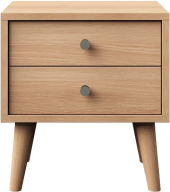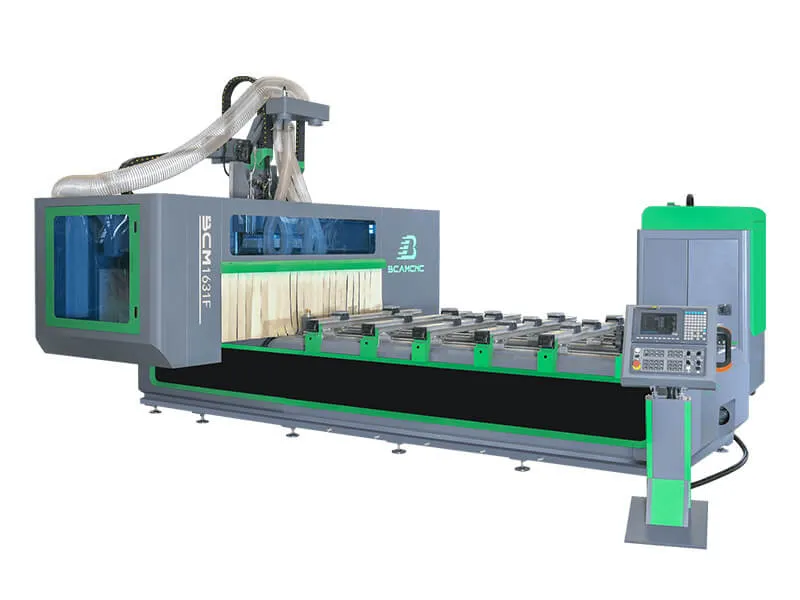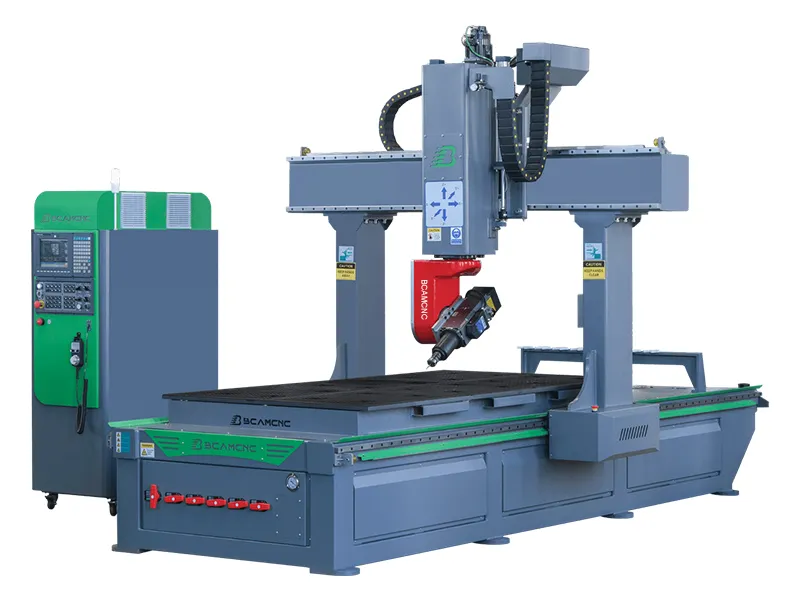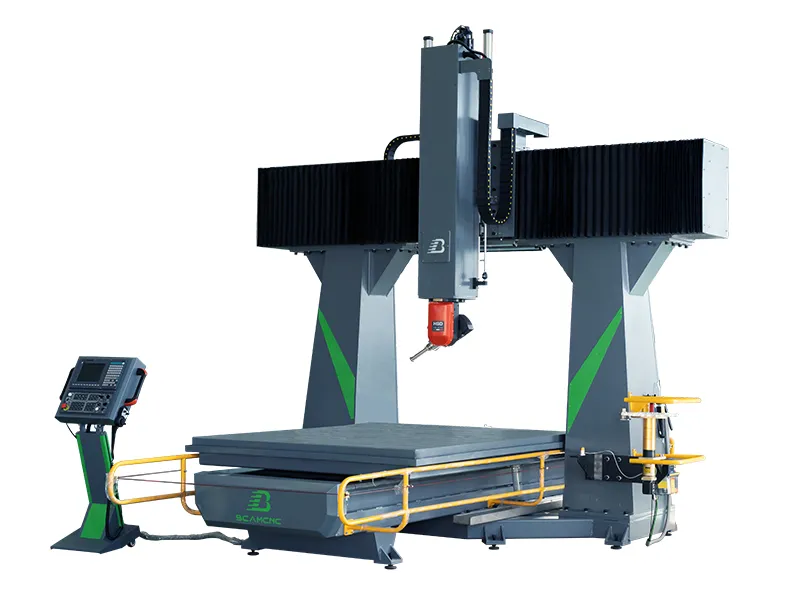Monday To Saturday
8:30 AM - 6:00 PM
Reliable 5-Axis CNC Routers for Any Material
Top 5-Axis CNC Routers for Aerospace, Automotive & Woodwork
5-Axis CNC Router offers precise cutting and milling for wood, aluminum, plastic, foam, and composites.Ideal for furniture, aerospace, automotive, and mold-making industries with smooth, reliable performance.Built to fit every budget and production need for efficient, versatile manufacturing.
$72,000.00 Original price was: $72,000.00.$68,618.00Current price is: $68,618.00.
$39,897.00 Original price was: $39,897.00.$38,443.00Current price is: $38,443.00.
$78,514.00 Original price was: $78,514.00.$75,001.00Current price is: $75,001.00.
$63,154.00 Original price was: $63,154.00.$60,929.00Current price is: $60,929.00.
Maximize Efficiency and Accuracy with BCAMCNC 5 Axis CNC Routers
BCAMCNC 5 Axis CNC Router Machines deliver unparalleled precision and flexibility for woodworking, furniture, cabinetry, plywood, MDF, aluminum, acrylic, plastics, foam, composite panels, and stone materials. Designed for complex 3D contouring, multi-axis cutting, milling, and tool-changing operations, these routers are perfect for cabinet making, custom furniture, signage, industrial parts, mold making, and prototyping. With high-speed spindles, micron-level repeatability, and CAM software compatibility, they reduce production time, improve workflow efficiency, and ensure consistent, high-quality results for industrial manufacturers and woodworking professionals alike.

5 axis CNC machines have become essential tools for industrial manufacturers seeking high-precision, efficient, and flexible machining of complex surfaces. When traditional 3 axis or 4 axis routers cannot achieve the desired geometry, five axis machining technology provides the solution. Featuring advanced computer control, high-performance servo drives, and precision engineering, five axis CNC routers enable automated, accurate processing of curved, multi-dimensional surfaces, making them a benchmark for industrial automation capabilities.
This technology plays a critical role in high-end sectors such as aerospace, automotive, and defense, where precision and efficiency are paramount. However, investing in a five axis CNC machine requires careful consideration. Prices for new units typically start around $100,000, and factors such as manufacturer reputation, warranty, payment options, and after-sales support can significantly affect the purchasing experience.
For manufacturers looking to maximize efficiency and quality, this guide provides insights on evaluating and selecting the right five axis CNC router for your production needs. By understanding the technical capabilities, industrial applications, and investment considerations, you can make informed decisions and choose the optimal machine to enhance your workflow, reduce production time, and maintain consistent high-quality output. Explore BCAMCNC’s top-rated five axis CNC router machines below to find the ideal solution for your business.
Definition of 5 Axis CNC Router Machine
A 5 axis CNC router is an advanced multi-axis CNC machining center designed for high-precision industrial manufacturing. Unlike standard 3 axis or 4 axis routers, a 5 axis CNC router adds two additional rotary axes, enabling simultaneous machining of five sides or faces of a workpiece. This capability allows manufacturers to achieve complex geometries, undercuts, and 3D contours in a single setup. Ideal for materials such as wood, MDF, plywood, composites, aluminum, acrylic, and plastics, 5 axis CNC routers reduce production time, improve surface quality, and increase workflow efficiency. Proper calibration ensures stability and micron-level accuracy, even for extended X-axis designs.
Working Principle of 5 Axis CNC Router Machine
The working principle of a 5 axis CNC router relies on coordinated movement along five axes:
• X-axis: moves the workpiece or tool front-to-back
• Y-axis: moves left-to-right
• Z-axis: moves up-and-down
• A/B/C axes: rotary axes that tilt or swivel the spindle or workpiece for multi-directional machining
By simultaneously controlling all five axes via CNC programming, the router can approach the material from multiple angles, enabling precision multi-surface cutting, 3D contouring, and complex undercut machining. Compared with 3 axis CNC router, five axis routers minimize errors, reduce the need for multiple clamping, and deliver smoother surface finishes. This principle allows industrial manufacturers to produce intricate designs, detailed cuttings, and high-quality prototypes efficiently.
Types of 5 Axis CNC Routers
5 axis CNC routers come in various configurations to meet different industrial and woodworking needs. The nine most common types include:
1. Trunnion-style machines: Feature a rotating table that tilts the workpiece, ideal for aerospace components and complex 3D parts requiring high precision.
2. Swivel-head machines: The spindle rotates to reach multiple angles without moving the table, suitable for mold making and artistic cutting.
3. Traveling-column machines: Offer large working areas with high rigidity, perfect for furniture panels, plywood, and composite boards.
4. Table-table machines: Both the table and spindle can rotate, allowing maximum flexibility for intricate 3D machining.
5. Head-table machines: Combine a tilting head and rotary table to achieve complex multi-axis cuts with high accuracy.
6. Continuous machines: Support uninterrupted 5 axis movement for seamless machining of free-form surfaces and aerospace parts.
7. Indexed machines: Allow rotary axes to move in discrete steps for precise positioning and efficient multi-part production.
8. Gantry-type machines: Feature a gantry structure for large-scale parts, including signage, cabinetry panels, and industrial molds.
9. Hybrid machines: Combine features from multiple types to deliver versatile solutions for specialized manufacturing and prototyping applications.
Each machine type is designed to maximize cutting efficiency, precision, and workflow flexibility, making them suitable for woodworking, furniture, cabinetry, mold making, aerospace, and industrial prototyping. Choosing the right 5 axis router depends on material size, part complexity, production volume, and desired machining speed.
Applications of 5 Axis CNC Router Machine
The 5 axis CNC router is engineered for high-speed, high-precision machining across a wide range of materials, including wood, MDF, plywood, plastics, acrylic, non-ferrous metals, composites, and mold materials. Its multi-axis capabilities open up advanced applications for industrial manufacturing and woodworking:
1. Edge trimming of molded and thermoformed parts: The additional rotary axes allow for precise trimming and finishing of molded plastics, composite panels, and other complex components, delivering smooth, professional edges.
2. Deep cavity mold making: Unlike 3 axis routers, which require long tools and slower cutting speeds for deep cavities, a 5 axis router uses shorter tools with dynamic multi-axis movements, enabling faster machining while reducing tool wear and breakage.
3. Molded plywood furniture and decorative components: The router supports complex shaping, cutting, and molding, making it ideal for custom furniture, cabinetry, and artistic wooden designs.
4. Detailed 3D machining and prototyping: Multi-directional movement allows intricate detailing, capturing fine details in materials such as wood, foam, acrylic, and aluminum for precise prototypes or decorative pieces.
Features of 5 Axis CNC Router Machine
5 axis CNC machines stand out for their efficiency, precision, and versatility. Key features include:
• Single-clamping multi-surface machining: Complex parts can be fully processed in one setup, eliminating repeated clamping and reducing alignment errors.
• Five axis linkage technology (X, Y, Z, A, C): Enables smooth 3D contouring, undercut machining, bevel cutting, hollowing, oblique holes, and special-shaped surfaces that are impossible on standard 3 axis machines.
• Comparison with 5-sided machining centers: Unlike five-sided centers, which can only access five faces without true rotational linkage, 5 axis CNC routers dynamically tilt the tool or workpiece, achieving full 3D freedom.
• Enhanced surface quality and workflow efficiency: Multi-axis control ensures consistent cutting conditions across complex surfaces, minimizing tool interference and reducing machining time.
• Compatibility with diverse materials: From hardwoods and MDF to composites, plastics, and aluminum, the 5 axis router handles a wide spectrum of industrial and decorative applications.
In contrast, traditional 3 axis CNC router operate with linear X, Y, and Z movement only, leaving the tool axis fixed. This limitation results in lower efficiency, restricted surface access, and potential surface quality issues when processing complex geometries.
BCAMCNC 5 Axis CNC Router Specifications
| Specification | Details |
|---|---|
| Brand | BCAMCNC – Trusted manufacturer of high-quality CNC machines |
| Spindle | HSD – High-speed spindle for efficient cutting and milling |
| Servo System | YASKAVA – Ensures smooth, precise movement along all axes |
| Inverter | Delta – Provides stable power and consistent motor control |
| Tool Magazine | Linear / Carousel – Supports fast automatic tool changes |
| Capability | 2D / 2.5D / 3D Machining – Suitable for wood, plastics, composites, metals |
| Control System | SYNTEC / OSAI – User-friendly CNC controllers with advanced programming |
| Price Range | $60,000 – $300,000 – Industrial-grade, prototyping, and high-volume production |
Pricing Guide for Industrial 5 Axis CNC Router Machines
The cost of purchasing a 5 axis CNC router depends on the brand, manufacturer, model, features, optional accessories, and whether the machine is new or used. For industrial buyers in 2025, the average price of a new high-end 5 axis CNC machine is approximately $108,000, while used machines can be obtained for around $36,000.
Professional-grade 5 axis CNC routers for manufacturing, prototyping, or large-scale production typically range from $100,000 to $150,000, depending on specifications, spindle power, tool magazine type, and CAM software compatibility.
For international procurement, buyers should also account for customs clearance, import taxes, and shipping costs when calculating the total investment. This ensures that businesses can plan accurately for industrial production budgets and operational efficiency.
Pros & Cons of 5 Axis CNC Machines
Pros of 5 Axis CNC Machines for Industrial Applications
1. High-Precision Free-Form Surface Machining
Five axis CNC machines can process complex curved surfaces that 3 axis machines cannot handle in a single setup, such as aerospace blades, ship propellers, and specialized molds. The ability to adjust tool angles and positions during machining ensures high accuracy and surface quality.
2. Improved Tool Efficiency and Reduced Interference
Additional rotation and swing axes allow optimal tool positioning, minimizing collisions with the workpiece, fixture, or cavity walls. Shorter tools can be used for deeper cavities, improving rigidity, reducing tool breakage, and enhancing overall machining efficiency.
3. Single Setup for Multi-Sided Machining
Complex parts can be completed in one clamping, reducing reference conversions and ensuring higher machining accuracy. This also lowers the need for additional fixtures, reduces workshop floor space requirements, and cuts maintenance costs.
4. Enhanced Productivity and Surface Quality
Five axis CNC machines allow side-edge cutting and complex profiling, enabling faster and more precise machining. Production cycles are shorter, and surface finish quality is significantly improved compared to traditional three axis machines.
5. Shortened Product Development Cycles
Industries like aerospace and automotive benefit from faster prototyping and mold-making for complex components, thanks to the integrated multi-axis processing capabilities of five axis CNC machines. This accelerates new product development and increases production success rates.
6. Versatile Complex Part Machining
Capable of drilling, tapering, cavity recesses, and other operations on intricate surfaces, five axis CNC machines expand manufacturing possibilities beyond the capabilities of 3 axis or 5 sided machining centers.
Cons and Challenges of 5 Axis CNC Machines
1. Complex Programming Requirements
NC programming for five axis machines is more abstract and requires advanced skills. Unlike 3 axis machines, programs must coordinate multiple rotary axes, check nonlinear errors, and calculate tool rotations. Skilled programmers and operators are essential.
2. High Demands on Controllers and Servo Systems
Accurate motion interpolation and dynamic response of the servo drive system are critical. Even minor errors in rotation axes can reduce machining accuracy.
3. NC Program Verification is Crucial
Due to the complexity and high cost of workpieces, collisions are common. Programs must be carefully verified, as adjustments during machining are more complicated than on 3 axis machines.
4. Tool Radius Compensation Limitations
Tool length can be compensated, but tool radius compensation is often invalid in five axis machining. CAM recalculation or specialized software solutions like LCOPS are necessary for precise tool path adjustments.
5. Singularity and Nonlinear Motion Issues
Rotating axes introduce kinematic challenges, including singularity points and nonlinear errors. Proper linearization and control strategies are required to avoid tool path deviations or axis flips.
6. Dependence on Advanced CAD/CAM Systems
Efficient five axis machining requires mature CAD/CAM software and experienced programmers to generate accurate tool paths and manage complex setups.
7. Higher Initial Investment
In addition to the machine cost, industries must invest in CAD/CAM systems, post-processors, and calibration programs to fully utilize the five axis capabilities. Although prices have become more accessible, they remain 30–50% higher than equivalent three axis machines.
Main Components and Accessories of 5 Axis CNC Machines
1. Main Structural Components
The core structure of a 5 axis CNC machine consists of the bed, column, and table. These parts bear both the static load of the machine and the cutting forces generated during machining. High rigidity is critical to maintain accuracy and stability. Industrial-grade CNC machines typically use Meehanite cast iron or welded steel structures for superior durability and vibration resistance.
2. Spindle Assembly
The spindle assembly includes the spindle motor, spindle shaft, spindle bearings, and housing. It is the power output unit of the machining process, controlling start, stop, and speed through the CNC system. The spindle’s performance directly impacts machining precision, stability, and efficiency.
3. CNC Control System
A 5 axis CNC machine relies on a numerical control system, consisting of the CNC controller, PLC (programmable logic controller), servo drives, and the operator interface. This system coordinates tool movements across all five axes, ensuring precise and complex machining operations.
4. Automatic Tool Change (ATC) System
The ATC system automates tool storage, selection, and replacement, enabling continuous multi-process machining without manual intervention. Key components include the tool magazine (carousel or linear type), tool arm, and manipulator mechanism. Some machines integrate the tool change function directly with the spindle or headstock for enhanced efficiency.
5. Auxiliary Systems
Auxiliary systems play a supporting but essential role in machining efficiency and reliability. These include:
Lubrication and cooling systems
Chip removal and protection systems
Hydraulic and pneumatic systems
Machine monitoring and detection systems
6. Automatic Pallet Change (APC) System
For fully automated production, some 5 axis CNC machines feature APC systems that allow multiple workpieces to be loaded and unloaded simultaneously. While one workpiece is being machined, other pallets can be prepared with new parts, reducing non-productive time and increasing overall throughput.
B2B Buyer’s Guide: How to Purchase a 5 Axis CNC Machine
Purchasing a 5 axis CNC machine for industrial production requires careful planning and due diligence. This guide outlines the key steps for business buyers to select the right machine, ensure quality, and optimize investment.
Step 1. Define Your Production Needs
Assess your company’s production requirements:
Types of materials (wood, plastics, metals, composites)
Required precision and surface quality
Production volume and cycle time
This step ensures you choose a machine with the right specifications and capacity for your operations.
Step 2. Establish a Budget Range
Determine the total investment your business can allocate, including:
Machine cost (new or refurbished)
Shipping, insurance, and customs fees
CAD/CAM software and tooling
Installation and training
Having a clear budget helps narrow down suitable models and suppliers.
Step 3. Research Reputable Suppliers
Compare multiple industrial suppliers based on:
Machine specifications and model options
Company reputation and B2B experience
Warranty and after-sales support
Case studies or references from other industrial clients
Step 4. Request Detailed Consultation and Quotation
Contact the supplier’s technical or sales team to:
Share your production requirements
Receive a tailored quotation with machine specifications, optional accessories, and pricing
Discuss lead times and delivery schedules
Step 5. Review Contract Terms
Before committing, carefully evaluate the sales contract:
Technical specifications and customization details
Payment terms and deposit requirements
Delivery, installation, and acceptance procedures
Warranty, training, and after-sales support agreements
Step 6. Monitor Manufacturing
Once the order is confirmed, suppliers typically provide updates during production:
Progress reports on machine assembly
Quality control and inspection documentation
Pre-shipment testing reports
Step 7. Inspection and Factory Acceptance
Industrial buyers often conduct Factory Acceptance Tests (FAT) to ensure:
Machine meets technical specifications
Spindle, servo system, and ATC operate correctly
Safety systems are functional
This step minimizes risk before shipping.
Step 8. Logistics and Shipping
Coordinate with the supplier on:
Shipping method and schedule
Export documentation
Insurance coverage during transport
Step 9. Customs Clearance
Ensure smooth import by preparing:
Customs declarations
Certificates of origin and technical documents
Any local compliance certificates
Step 10. Installation, Training, and Support
After delivery, professional suppliers provide:
On-site installation and commissioning
Operator training for CNC programming and maintenance
Ongoing technical support, including remote diagnostics or field service
Secure Payments
Tellus gravida ipsum aut facilisis tempus at et aliquam estsem.
Free Shipping
Non pulvinar aenean ultrices lectus vitae imperdiet vulputate a eu.
Gifts & Sales
Aliquet ullamcorper leo mi vel sit pretium euismod eget libero.
24/7 Support
Nullam iaculis vestibulum arcu id urnain pellentesque volutpat quis.

Important updates waiting for you!
Subscribe and grab 20% OFF!




